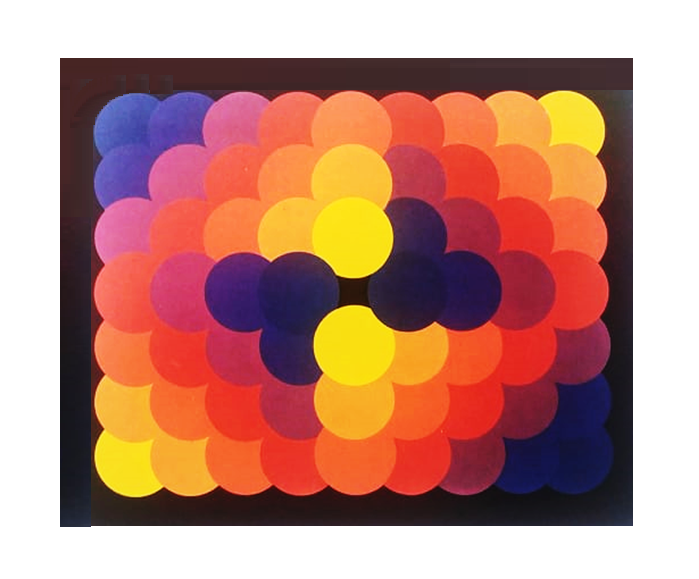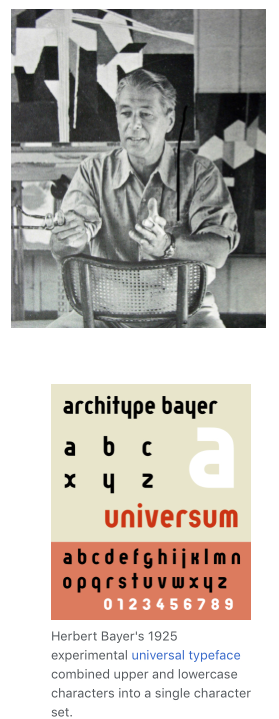

Herbert Bayer’s training at the Bauhaus, a German art school dedicated to the fusion of art, design and function, drove him to be an innovator in all areas of his work and defined his design ethic.
Bayer was born in Haag, Austria, in 1900 and entered the Bauhaus in 1921. After becoming a master at the age of 25, Bayer realized he was “too young to teach.” He worked in advertising in Berlin for ten years, then immigrated to the United States in 1938 to escape Nazism. In New York, he designed a Bauhaus exhibition for the Museum of Modern Art that attracted the attention of Walter Paepcke, president of the Container Corporation of America (CCA). Bayer eventually became responsible for the CCA’s entire aesthetic vision, his first foray into the concept of creating a total corporate environment. Their pioneering vision of the symbiotic relationship between corporate culture and an aesthetic philosophy was the realization of his Bauhaus ideology.
Tom Baird worked for Container Corporation of America’s Mexico division and, as head of the Graphic Design Department, he met and became friends with Herbert Bayer during his many visits to Mexico in the late 1960s and early 1970s. “Bayer’s Mexican sojourn produced a dramatic shift in his color palette. Bayer’s colors became bolder, more vivid and unlike anything he had previously produced.” (1)
Walter Paepcke also offered Bayer a unique opportunity to aid in the creation of a cultural center in Aspen, Colorado. Although he was primarily tasked with the marketing, landscape design and architecture of the Aspen Institute of Humanistic Studies, he was also very involved with the rejuvenation of Aspen from a dilapidated mining town to a modern cultural hub and ski resort. Paepcke’s vision for the Institute was to encourage people to share ideas and cultural values to nurture their mind, body and spirit for the betterment of humanity. This “Aspen Idea” echoed Bayer’s notion of the artist’s responsibility to enhance the quality of life for all. (2)
(1). Herbert Bayer: Mountains and Convolutions, 1944-1953. Doerr-Hosier Center, The Aspen Institute
(2). bayer & bauhaus: how design shaped aspen, Aspen Historical Society
Herbert Bayer – Sin Titulo Serigrafia/Silkscreen
El estudio de Herbert Bayer en Bauhaus, una escuela de arte alemana dedicada a la fusión de arte, diseño y función, lo llevó a ser un innovador en todas las áreas de su trabajo y definió su ética de diseño.
Bayer nació en Haag, Austria, en 1900 e ingresó en la Bauhaus en 1921. Después de convertirse en maestro a la edad de 25 años, se dio cuenta de que era “demasiado joven para enseñar”. Trabajó en publicidad en Berlín por diez años, luego emigró a los Estados Unidos en 1938 para escapar del nazismo. En Nueva York, diseñó una exposición de Bauhaus para el Museo de Arte Moderno que atrajo la atención de Walter Paepcke, presidente de la Container Corporation of America (CCA). Bayer eventualmente se hizo responsable de toda la visión estética de la CCA, su primera incursión en el concepto de crear un entorno corporativo total. Su visión pionera de la relación simbiótica entre la cultura corporativa y una filosofía estética fue la realización de su ideología Bauhaus.
Tomas Baird trabajó para la sucursal mexicana de Container Corporation of America como jefe del departamento de diseño gráfico, y ahi se hizo amigo de Herbert Bayer durante sus muchas visitas a México en la década de 1960. “La estadía mexicana de Bayer produjo un cambio dramático en su paleta de colores. Los colores de Bayer se volvieron más atrevidos, más vivos y diferentes a todo lo que había producido anteriormente”. (1)
Walter Paepcke también le ofreció a Bayer una oportunidad única para ayudar en la creación de un centro cultural en Aspen, Colorado. Aunque su tarea principal era la comercialización, la planificación del diseño del paisaje y la arquitectura del Instituto de Estudios Humanísticos de Aspen, también estuvo muy involucrado en el rejuvenecimiento de Aspen, desde un pueblo minero en ruinas a un moderno centro cultural y estación de esquí. La visión de Paepcke para el Instituto fue animar a las personas a compartir ideas y valores culturales para nutrir su mente, cuerpo y espíritu para el mejoramiento de la humanidad. Esta “Idea Aspen” se hizo eco de la noción de Bayer de la responsabilidad del artista de mejorar la calidad de vida para todos.(2)
(1). Herbert Bayer: Mountains and Convolutions, 1944-1953. Doerr-Hosier Center, The Aspen Institute
(2). bayer & bauhaus: how design shaped aspen, Aspen Historical Society
